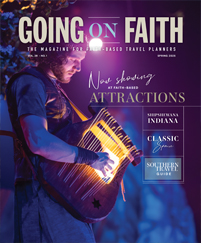by Brian Jewell and Eliza Myers
Beauty in bloom
Midwestern gardens are bursting with color

From electric iris blues to deep greens and even zebra stripes, you’ll be amazed at the colors in the gardens of the Midwest.
From Minnesota to Ohio and almost every state in between, the Midwest is rich in arboretums and botanical gardens. Here in the heartland of America, visitors can find plants from destinations far and wide. Hearty shrubs and hardwoods thrive in the northern states, and conservatories and greenhouses are home to exotic plants from Costa Rica, Madagascar and other faraway places.
The next time your group takes a trip through the Midwest, add some color to your visit by stopping at one of these great gardens.
Olbrich Botanical Gardens
Madison, Wis.
Visitors to the Olbrich Botanical Gardens can see a number of notable displays, including a Thai pavilion that is the only one of its kind in the United States.
“The pavilion was a gift to the University of Wisconsin Madison from the Thai government and the Thai chapter of the alumni association,” said Sharon Cybart, manager of marketing and public relations at the gardens. “It was built in a Thai construction style, which means there are no nails and no screws. It was built in Thailand and then disassembled and shipped to Wisconsin. Thai artisans came along to help put it together when it arrived here.”

The pavilion is detailed with gold leaf and is surrounded by a Thai-style garden complete with ornamental grasses, bamboo and a clipped tree art called mai dat. The area also has an elephant statue that was donated to the gardens by a Thai princess.
Inside Olbrich’s pyramid-shaped conservatory, visitors can experience some of the sights and sounds of a tropical rain forest.
“There are waterfalls, bridges, streams and ponds,” Cybart said. “We have blooming orchids, and all sorts of palms and exotic plants. It’s open year-round, and it’s a great attraction in the winter months.”
Other interesting features at Olbrich include a formal rose garden with a two-story rose tower and an English-style sunken garden with an 80-foot-long reflecting pool.
Cleveland Botanical Garden
Cleveland
Located in the cultural heart of the city on University Circle, the Cleveland Botanical Garden brings some 5,000 plants from all over the world to urban Ohio.
“We are a jewel in the midst of the city,” said Cynthia Duckenbrod, the garden’s director of horticulture. “We have 10 acres of highly landscaped boutique-style gardens. We also have an 18,000-square-foot glasshouse that has two ecosystems: a Madagascar desert and a Costa Rican rain forest.”
The outdoor sections include a Japanese garden, a woodland wildflower garden and a terrace garden that grows tropical ornamental vegetables, such as artichokes and peppers. The formal English herb garden is almost 50 years old and features fragrant varieties of thyme, basil, lavender and other herbs.
Inside the glasshouse, visitors will find two distinct areas that have been planted with specimens not native to the American Midwest.
“Our Madagascar plants are so strange — we like to call them weird and wonderful,” Duckenbrod said. “They look completely different than the plants of our desert Southwest. They are succulents, and some of them are extremely spiny.”
Among the highlights of the Madagascar desert ecosystem are vanilla orchids and avocado trees. More orchids can be found in the Costa Rica rain forest area, along with birds, butterflies, tortoises and lizards from that part of the world.
Powell Gardens
Kingsville, Mo.
About 30 miles east of Kansas city, in Kingsville, Mo., visitors to Powell Gardens will find a place that makes the most of its Midwestern home.
“Powell Gardens is a great Midwestern garden,” said Callen Fairchild-Zind, director of marketing at the gardens. “Part of our mission is to really embrace the Midwestern spirit of place. We have very Midwestern architecture, including the largest collection of Fay Jones architecture. He was a student of Frank Lloyd Wright.”
Jones-designed buildings at the gardens include a visitors center, a meditation chapel and a meadow pavilion. The architecture complements garden areas such as an island garden, a rock and waterfall garden, and a perennial garden with 400 to 500 different varieties of daylilies in bloom during the summer.
This summer, Powell Gardens is opening a new 12-acre expansion, called the Heartland Harvest Garden.
“It will be the nation’s largest edible landscape,” Fairchild-Zind said. “Everything in the garden will have a food use. It will have more than 2,000 different types of food plants.”
The Heartland Harvest Garden will be broken into sections displaying many varieties of fruits and vegetables. Visitors will find displays of different apple and peach trees, as well as a number of various grapevines. The centerpiece will be the Quilt Gardens, which will comprise four different areas planted in the traditions of Missouri and Kansas quilts.
www.powellgardens.org
Frederik Meijer Gardens and Sculpture Park
Grand Rapids, Mich.
Natural beauty and artistic expression come together in a grand way at Frederick Meijer Gardens and Sculpture Park. In addition to horticultural displays, the park is home to some 200 sculptures, many displayed outdoors in the garden setting.
“It’s unique because it’s not the typical outdoor area for sculpture,” said Amy Sawade, the park’s public relations specialist. “Our sculpture is placed very strategically in natural environments. We have sculpture hidden in little groves, surrounded by wildflowers and tall trees.”
The sculpture section of the park comprises about 30 acres and features original works by Auguste Rodin and other famous artists. The outdoor area holds about 100 sculptures, which visitors can see by walking or taking a narrated tram ride. Another 100 are on rotating display in an indoor gallery that holds three exhibitions each year.
There are also a number of other gardens on the campus. The 1930s-era farm garden features a re-created farmhouse, as well as heirloom vegetables and plants from that era. Other outdoor areas are an English perennial garden, a seasonal garden and a woodland shade garden.
The park also has a number of special indoor displays, among them an arid garden, a carnivorous planthouse and a five-story tropical conservatory. During March and April, the conservatory is populated with butterflies from around the world.
“Visitors can actually see the chrysalis and see the butterflies emerge in our butterfly bungalow,” Sawade said. “When they’re ready to fly, we release them into the conservatory.”
Klehm Arboretum and Botanical Garden
Rockford, Ill.
Created on the site of a former private nursery, Rockford’s Klehm Arboretum and Botanical Garden features a number of unlikely transplants.
“The original owners traveled extensively, and they brought back all sorts of things from the Far East and overseas that aren’t native to this climate,” said executive director Jane Snidely. “Many of them managed to survive and thrive in this environment. We have quite a few magnolia trees, and a Nikko fir and an Irish spruce, which are both very rare specimens.”
Visitors will find a number of garden areas at the arboretum, including a formal fountain garden, an azalea garden and a butterfly garden. A children’s garden features a hedge maze and a lookout tower. A series of five demonstration gardens are planted according to themes; one, called the Pizza Garden, is planted with all of the different vegetables used to top pizzas.
For the past two years, the arboretum has also participated in the nationwide Plant a Row project.
“The idea is for home gardeners to plant some extra rows of vegetables and then take them to a local food bank,” Snidely said. “So we do it on a large scale here, with an entire Plant a Row garden, and we use the food to help local charities.”
Groups can schedule docent-guided tours by contacting the arboretum staff two weeks in advance of their visit. Visitors can also take self-guided tours on the paved walking paths or unpaved trails on the property.
Minnesota Landscape Arboretum
Chasca, Minn.
Part of the University of Minnesota system, the Minnesota Landscape Arboretum offers groups a host of things to see during their visit.
“We comprise 1,300 acres of land, so it’s a very large area,” said Barb DeGroot, the arboretum’s public relations specialist. “It encompasses prairie areas, big woods, over 30 display gardens and more than 40 general plant collections.”
 f their own landscapes.
f their own landscapes.The arboretum has traditional garden areas, such as rose gardens, herb gardens and a lilac garden. There are also unconventional areas, such as the weed collection, which helps visitors identify weeds they might find in their own yards.
New this year is an exhibit called Waterosity that deals with gardening and the environment.
“It’s a celebration of fresh thinking about people, plants and water,” DeGroot said. “We’ll have demos of how to return rainwater to the earth in a section called Harvest Your Rain. And we’ll have some public art installations all around the theme of water.”
Groups can take a tram ride through the arboretum’s three-mile drive, which includes the popular crabapple grove. The facility also has a gift store, a restaurant and an art gallery in the visitors center.
Soul of the city
Ethnic neighborhoods flavor the cities of the Midwest
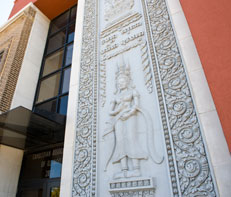
The shaded streets, row houses and historic homes of Midwest neighborhoods have seen their share of dramatic stories. Many of these neighborhoods were once home to thriving ethnic communities, and some still are.
So often our travel takes us to downtowns, outlet malls or sprawling resorts, which are great places to have fun but reveal little of the character of the places we’re visiting. But when you take the time to get out and visit the neighborhoods where people live, work and play, you can often see a more intimate and human side of a destination.
In cities from Milwaukee to Columbus, Ohio, ethnic and historic neighborhoods are alive and thriving.
Chicago Neighborhood Tours
Perhaps no other city in the Midwest has seen as much diversity as Chicago, a metropolis that has welcomed immigrants and residents from all over the world. Today, Chicago Neighborhood Tours offers groups and visitors a number of trips through various neighborhoods that are full of ethnic flavor.
“We offer three different types of tours, all visiting neighborhoods or looking in depth at historical situations or one particular ethnic group,” said Patricia Sullivan, Chicago Neighborhood Tours manager. “We do 28 different tours total, all having to do with Chicago neighborhoods and the ethnic groups that settled there.”
One of the most interesting areas the tours visit is Albany Park, a neighborhood that began with many German and Swedish immigrants and then later became a Jewish enclave. Today, more than 35 languages are spoken in the neighborhood, and groups stop at a cultural center and local restaurants for a taste of the ethnic flavor.
Another tour takes participants to Historic Brownsville, a predominantly African American community.
“We stop at Little Black Pearl Art and Design Center,” Sullivan said. “It was started by a woman who gave art lessons to get kids off the street after school. Now they offer performances and dance, and we visit the art gallery there.”
In Little Village, groups visit Mexican bakeries and candy stores; on the Hyde Park and Kenwood tours, visitors stop outside the Chicago home of President Barack Obama.
www.chicagoneighborhoodtours.com
Detroit
For generations, immigrants from many parts of the world have come to Detroit seeking work in auto production and other industries in the area. Today, neighborhoods and suburbs near town reflect the various groups that make Detroit home.

One of the city’s best-known ethnic communities is Greektown, which was started in the 1880s and has become an integral part of downtown Detroit. Young Greek men came to the city from Europe in the 19th century to work in factories and settled this neighborhood with traditional Greek shops, restaurants and coffeehouses.
In the early 20th century, the area faced extinction as Greek residents began to move out of the area, and local buildings were demolished. So, in 1903, local business owners established the Greektown Merchants Association and began to revitalize their district. Today, the association hosts the large annual Greektown Festival.
Visitors to Greektown will find strong remnants of Greek culture, as well as further international flair, such as Italian and Thai restaurants.
Detroit and the surrounding areas are also home to Polish, Arab and Mexican communities, which have museums and cultural centers open for visitors.
German Village
Columbus, Ohio
During the 1840s, German immigrants began settling in a neighborhood that was then on the south side of Columbus, Ohio. By the 1860s, one-third of Columbus’ residents were German American.
In the early 20th century, German influence in the area began to fade. But since 1960, the German Village Society has been working to preserve it in this distinctive neighborhood, which is now near the center of town.
“The Germans that settled here built very sturdy homes, and we have a unique building stock in the city,” said Jody Graichen, director of historic preservation programs for the German Village Society. “The characteristic homes are story-and-a-half cottages, or double Dutch cottages, usually made of brick. They’re very practical in nature and very orderly.”
As the German community became more prosperous, some residents built larger homes in Italianate or Queen Anne styles. Today visitors can see both modest and elaborate houses on home and garden tours in the neighborhood, which have been taking place for 50 years.
Another key area in the neighborhood, Schiller Park, has been around since the 1890s, and has a sculpture of Frederick von Schiller, an influential early German settler in the area. The park is surrounded by homes, as well as shops and restaurants that make great places to visit during a day in the village.
“We have Schmidt’s, which is a German restaurant,” Graichan said. “It’s in its fourth generation now, and it’s wonderful. We also have a German bakery, and that’s wonderful too.”
Milwaukee
Milwaukee’s surprising ethnic diversity and history can be found in neighborhoods, churches and markets all over town.
Near downtown, Historic Brady Street is full of buildings constructed between 1860 and 1930 and was a main street for Milwaukee’s immigrant community. Irish, German, Polish, Italian and Russian groups have made their homes in the area, which reflects a mix of these cultures and more in its numerous specialty shops.
Milwaukee’s German roots are evident on Old World Third Street, an area known for its cobblestone streets, historic architecture, and great sausage, cheese and spice shops. One of the favorite places to visit in this district is Maders, which features traditional German food and historic artifacts, such as a 20-foot hand-carved oak table that once belonged to the famous Red Baron.
Church groups will also enjoy a visit to the Basilica of St. Josaphat. It’s the only basilica in Wisconsin and a miniature replica of St. Peter’s Basilica in Rome. The church was built by Milwaukee’s Polish immigrants, who saved money and purchased many materials for the church from the demolished Chicago Post Office and Customs House. The finished basilica was dedicated in 1901, and today’s visitors can still see the imprint “US Government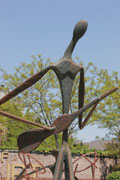 ” on the church doorknobs.
” on the church doorknobs.
www.visitmilwaukee.org
Ransom Place
Indianapolis
In a six-block area near downtown Indianapolis, visitors will find Ransom Place, an African American neighborhood developed in 1865. The district became Indiana’s first African American neighborhood to be listed on the National Register of Historic Places and was home to numerous prominent African American citizens.
On tours of the neighborhood today, groups can visit Bethel AME Church, which was established in 1836.
“It sits right along downtown Indy’s Central Canal, with views of the city’s skyline,” said Chris Gahl, associate director of communications at the Indianapolis Convention and Visitors Association. “Stepping inside the church, visitors can tour the sanctuary and historic organ that has been leading the congregation for decades. Outside, much of the original church facade is still in place.”
Another popular stop in the neighborhood is the Crispus Attucks Museum, a former school that has been converted to showcase the achievements of African Americans nationwide. Visitors will find a varied collection of cultural artifacts on display, from photos of basketball legend Oscar Robertson to sheet music from Indiana-based musicians.
Groups will also appreciate the many cultures to be encountered in Ransom Place today.
“Ransom Place remains an ethnically diverse enclave,” Gahl said. “It’s a neighborhood mixing international students with African American, Hispanic and Caucasian residents within a few square blocks.”
Down by the riverside
Rivers are the lifeblood of Midwestern cities and towns
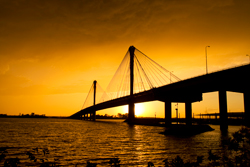
Visitors can catch views of the Midwest’s rivers from all kinds of angles, whether through the bones of a towering dinosaur exhibit at the Science Museum of Minnesota or from the top of the 630-foot St. Louis Gateway Arch. Riverfront cities across the Midwest can keep guests busy at numerous attractions, or provide a place to relax and watch barges float by.
Davenport, Iowa
Although once deemed the most dangerous section of the upper Mississippi River, the Rock River Rapids needn’t concern passengers on the Channel Cat Water Taxi any longer, because the dredging of the river has slowed the rapids. Visitors can cross the tamed waters on the river taxi to explore five different stops in the Quad Cities area.
Connected by the muddy Mississippi, the Quad Cities’ five towns lend their share of riverfront attractions, quaint shops and dining options.
“One of our greatest assets is our trails,” said Roxie Lucas, vice president of finance and administration for the Quad Cities Convention and Visitors Bureau. “The American Discovery Trail and the Great River Trail intersect here, so we are at the crossroads of two trails crossing America.”
One stop in the Quad Cities serves as a remembrance of the Confederate prisoners who were once held on a small island in the area. The now-active military base showcases its Civil War history at the 1905 Rock Island Arsenal Museum, which contains an extensive collection of small-arms weapons.
Tours of Lock and Dam 15 also run at Rock Island from the Mississippi Visitors Center. There groups can observe boats passing through the lock while learning about river history, and the river’s lock and dam system.
The Quad Cities’ riverfront is also home to the Putnam Museum and Imax Theater, the Figge Art Museum and the River Music Experience, which immerses guests in the music of the Mississippi River.
St. Paul, Minn.
Minnesota’s capital, St. Paul, boasts more shoreline than any other city on the Mississippi River. The 26-mile shoreline provides plenty of room for the city’s riverfront attractions, among them Broadway shows, museums, parks and festivals like the Twin Cities Jazz Festival.
“The river is the life of St. Paul,” said Ted Davis, vice president of marketing and public affairs for the St. Paul Convention and Visitors Bureau. “Our downtown sits directly on the bluffs by the river. It is one of our best assets for recreation and commerce.”
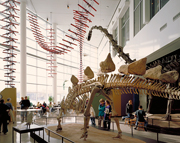 The Science Museum of Minnesota draws visitors with its Dinosaurs and Fossils Gallery, which holds one of the largest triceratops skeletons in the world. The museum also features one of the nation’s only convertible Imax dome Omnitheaters, as well as other traveling exhibits, such as this summer’s Titanic: The Artifact Exhibit.
The Science Museum of Minnesota draws visitors with its Dinosaurs and Fossils Gallery, which holds one of the largest triceratops skeletons in the world. The museum also features one of the nation’s only convertible Imax dome Omnitheaters, as well as other traveling exhibits, such as this summer’s Titanic: The Artifact Exhibit.
Not far from the science museum, the Mississippi River Visitors Center displays more exhibits on river biology and history. The center also serves as an entrance to the Mississippi National River and Recreation Area, where groups can hop on a tour boat.
The Padelford Packet Boat Company’s paddle wheelers cruise the river in search of bald eagles, herons and egrets on narrated historic cruises. Groups can choose from dinner cruises or daily sightseeing cruises that drift by St. Paul High Bridge, Pig’s Eye Cave and Historic Fort Snelling.
St. Louis
A short tram ride up the shiny St. Louis Gateway Arch lends a view of the river and the city from the country’s tallest man-made monument. The trams run at 4 miles per hour up the curve of the 630-foot steel arch, with narration provided for visitors.
“A trip to St. Louis is not complete without a trip to the Arch,” said Donna Andrews, director of public relations for the St. Louis Convention and Visitors Commission. “If people don’t want to go up the tram, they can visit the Museum of Western Expansion.”
The museum holds rare Indian peace medals, a covered wagon and scenes with animatronic figures depicting Western settlers. From the Gateway Arch Riverfront, groups can learn about the arch’s construction in the Monument to the Dream film or see an Imax movie at the nearby Odyssey Theatre.
To duplicate the experience idealized by author Mark Twain, Gateway Arch Riverboats’ two 19th-century replica steamboats ride down the Mississippi River. Once aboard the Tom Sawyer and Becky Thatcher vessels, guests can dine, watch the skyline and listen to live music.
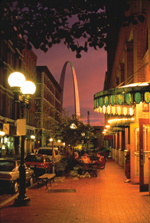
Shopping at Laclede’s Landing not only rewards customers with a variety of entertainment stores, but also paints a picture of 19th-century St. Louis with renovated warehouses and cobblestone streets.
“We have put $4 billion into downtown St. Louis,” said Andrews. “We have the new Busch Stadium and a real sense of community downtown. The city is really on a comeback.”
Evansville, Ind.
Perched on the banks of the Ohio River, Evansville lets guests see the riverfront on the 1942 warship the LST 325. During World War II, the landing ship tank served as an amphibious vessel designed to deposit tanks, troops and supplies directly onto enemy shores.
After Arctic operations in the 1950s and service in the Greek navy, the ship moved to Evansville to allow tours of its historic hull. Each year, costumed interpreters use the ship to re-enact its historic role in the invasion of Omaha Beach on D-Day.
Another riverfront attraction, the Evansville Museum of Arts, History and Science, showcases a $10 million permanent art collection ranging from 16th-century paintings to 20th-century sculptures. The museum also features traveling exhibits, a planetarium and the stagecoach driven by Calamity Jane.
“The riverfront was renovated in 2000,” said Marilee Fowler, executive director of the Evansville Convention and Visitors Bureau. “There are a lot of cities that don’t have a view of the river, but we are able to use our levee in an appealing way so people still have a visual picture of the river.”
Visitors can experience Evansville during its liveliest moments at one of the city’s yearly festivals. Country musicians, swing acts and rock groups headline each June at the Freedom Fest, which also features aerial entertainment.
Cincinnati
During the time of slavery, the Ohio River was a natural barrier between the South and the free North, and many runaway slaves crossed the river in their escapes to freedom. Today, the river flows beside the National Underground Railroad Freedom Center in Cincinnati.
The 2004 museum charts African Americans’ and others’ quests for freedom with an introductory video, exhibits on freedom activists like Reverend John Rankin and historic artifacts such as the Slave Pen. The Slave Pen, a 19th-century cabin recovered from a farm less than 60 miles from the Freedom Center, illustrates how slave traders once held slaves captive in shackles before selling them.
The Struggle Continues exhibit illuminates guests on how slavery still exists in the world through abstract images combined with audio.
Next door to the center sits the Great American Ballpark, which hosts the games of baseball’s first professional f ranchise, the Cincinnati Reds.
ranchise, the Cincinnati Reds.
“The heart and soul of our waterfront is at the Reds’ Great American Ballpark,” said Linda Antus, president of the Cincinnati Regional Tourism Network. “There is a lot of wonderful energy that happens at the games, and it is right on the waterfront.”
In addition to watching a game, fans can tour the Reds Hall of Fame Museum, which chronicles the historic team through videos, recorded radio calls and artifacts. One interactive exhibit even allows visitors to attempt fielding, batting and pitching.
To see the city from the river, guests can ride the Ducks in Newport, Ky., or dine on one of B.B. Riverboat’s vessels, such as the Victorian Belle of Cincinnati.
Alton, Ill.
The Mississippi, Illinois and Missouri rivers all converge within Alton’s River Bend Region to create a town full of history, scenic views and antique shopping. The city focuses on its river ties at the National Great Rivers Museum, beside the Melvin Price Locks and Dam.
The museum’s aquarium, videos and large models of the bluffs teach visitors about the Mississippi River. Another exhibit teaches guests how to guide a 1,000-foot tow of barges under a bridge and through a lock using the same type of simulator that trains river pilots.
“Alton is a real river town,” said Suzanne Halbrook, public relations director for t





